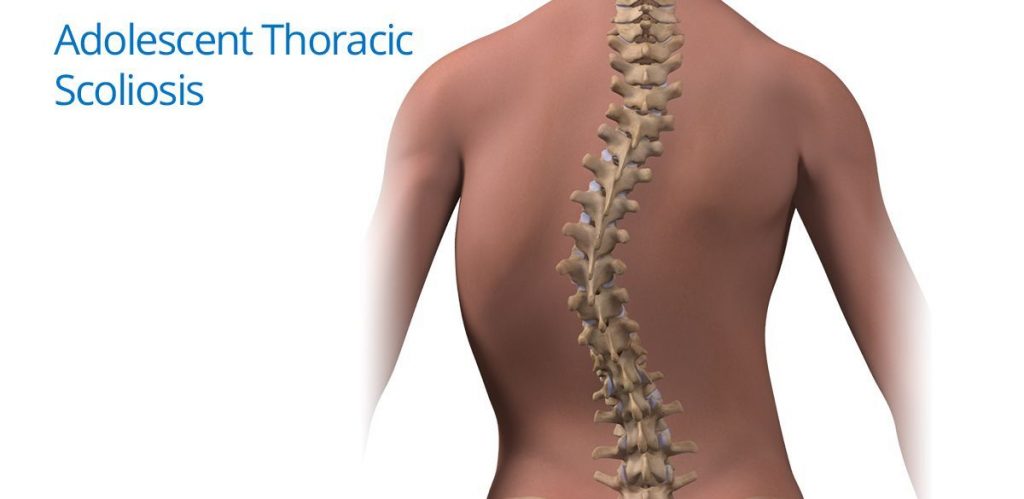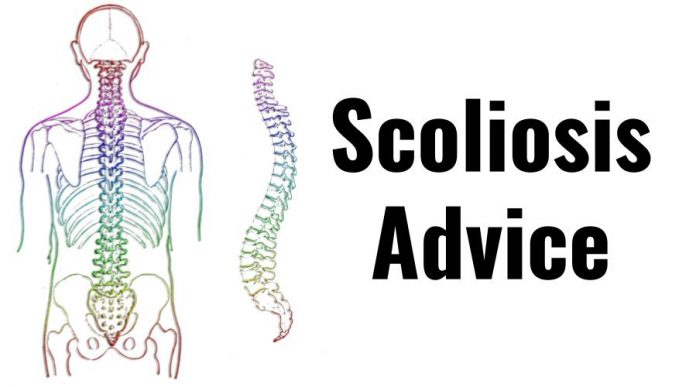Scoliosis is an abnormal curvature of the spine. Normally, the shape of the spine includes a curve at the top of the shoulders and a curve at the bottom of the back. But in people who have scoliosis, the spine is curved from one side to the other or in the shape of “S” or “C”. Read more about Home Remedies To Treat Scoliosis
The problem usually starts during the growth spurt just before puberty, but it can occur at any time.
Some common signs and symptoms of scoliosis include unequal shoulders, a scapula that is more prominent than the other, an unequal size and a hip that is higher than the other. This can cause pain and discomfort. In addition, if the problem gets worse, the spine can turn or twist, causing the ribs to go to one side of the body.
Experts do not know exactly what causes scoliosis. According to the American Association of Neurological Surgeons, about 80% of scoliosis cases have no identifiable cause. However, experts believe that heredity is a common factor because the problem is happening in families.
Other causes may include neuromuscular conditions (cerebral palsy or muscular dystrophy), a birth defect that affects the development of bones in the spine, spinal cord injury, or spinal cord infection.
Scoliosis is divided into structural and non-structural categories. In structural scoliosis, it is a permanent problem that occurs due to a disease, injury or congenital anomaly. In non-structural scoliosis, the curves are temporary and can be fixed.
While boys and girls may develop mild scoliosis, girls are at higher risk of developing complications, which may include lung damage, heart problems and back problems.
Because of significant changes in body structure, people with scoliosis often become embarrassed by their appearance.
Most cases of scoliosis are benign, and it may be necessary to wear an orthosis to prevent the curve from getting worse. In fact, wearing a brace is considered the first line of treatment when the problem is diagnosed early.
In some cases, surgery or orthopedic insertions may be needed to prevent the curvature from worsening and to straighten the spine in severe cases.
Apart from the medical intervention, certain exercises, nutrients, and lifestyle changes can improve the overall health and well-being of a person with scoliosis.
Here are some of the best ways to treat scoliosis at home.
Table of Contents
1. Regular Exercise
Regular exercise helps keep your spine strong no matter if you have scoliosis. But doing targeted exercises can help strengthen and even help to realign the spine safely and effectively.
In a systematic review published in BioMed Research International in 2015, the researchers concluded that, according to the evidence of average quality, an exercise program is superior to the controls to reduce the angle of Cobb, the angle of rotation of the trunk, the angle of thoracic kyphosis and the angle of lumbar lordosis. as well as improving the quality of life of patients with adolescent idiopathic scoliosis (AIS).
Exercises like walking, running, playing soccer, doing yoga or swimming can be very helpful. However, it is important to talk to your doctor about what physical activities are healthy and safe options for your condition.
 2. Stretching
2. Stretching
Stretching helps a lot if scoliosis starts to cause pain. It helps reduce pain by releasing tension in the muscles surrounding the spine while improving flexibility and increasing your range of motion.
In addition, it increases blood flow to the joints, helping to keep the body supple.
- Stand straight with your feet shoulder-width apart.
- Bring your arms in front of your chest.
- Slowly, pull your arms back and press your shoulder blades together.
- Try to stretch the chest as much as you can.
- Pause for a few seconds and repeat again.
- Do it for 10 minutes at a time, a few times a day.
3. Acupuncture
Acupuncture is another effective option for relieving the discomfort of scoliosis. In acupuncture, some acupuncture points are stimulated to help improve the pain of scoliosis.
A study published in 2008 in Scoliosis and Spinal Disorders reports that a session with real acupuncture (verum) seems to have an influence on scoliosis deformity in patients whose curvature does not exceed 35 degrees. However, further study of the effect of acupuncture in the treatment of patients with scoliosis is necessary.
4. Alternating Hot and Cold Therapy
Applying alternating hot and cold compresses can help relieve the peacock and discomfort associated with scoliosis.
The heat generated by the hot compresses will help soothe the pain, while the cold temperature of the cold compress will reduce the inflammation.
- Wrap a pack of frozen peas in a towel. Similarly, wrap a heating pad or hot water bottle in a small towel.
- Place the cold pack on the painful area for 2 minutes.
- Replace the cold pack with the hot pack and hold for another 2 minutes.
- Continue alternating the 2 packs for 15 to 20 minutes.
- Repeat the process 3 times a day or as needed.
Note: Make sure you always end the session with the cold pack.
5. Biofeedback
An alternative treatment, biofeedback can also provide relief from the symptoms of scoliosis.
In this type of treatment, a person becomes aware of the reactions of his body and slowly learns to control these reactions by his actions.
A study published in 2001 in Prosthetics and Orthotics International analyzed the effectiveness of audio-biofeedback in postural training for AIS patients and found that long-lasting active spinal control could be achieved by the patient’s own spinal muscles.
For biofeedback, you must consult an expert.
6. Magnesium
Scoliosis can get worse because of an imbalance of magnesium and calcium in the body. You can correct this imbalance by taking a magnesium supplement or by increasing the amount of magnesium you receive from your diet.
In addition, magnesium can help strengthen the spine. It stimulates the reuptake of calcium that can help maintain strong muscles and prevent cramps.
Take a magnesium supplement only after consulting your doctor.
You can also get your daily dose of magnesium by eating almonds, avocados, bananas, beans, pumpkin seeds, tofu, soymilk, cashews, pecans, walnuts, potatoes, yogurt, molasses, whole grains and green leaves. vegetables.
7. Turmeric
Being anti-inflammatory in nature, turmeric can help reduce the discomfort of scoliosis.
The curcumin active ingredient in turmeric can help reduce chronic pain and inflammation.
Include turmeric in your daily kitchen or drink a glass of turmeric milk twice a day. To prepare turmeric milk, heat 1 teaspoon of turmeric powder in 1 glass of milk (if dairy products do not suit you, use almond milk). You can also add some cinnamon sticks for added taste as well as health benefits. Sweeten the drink with a little honey.
8. Quit Smoking
Smoking is bad for your health, especially when you have health problems, including scoliosis. It delays the healing of tissues and inhibits bone healing.
In fact, it is often advisable to stop smoking before opting for spinal surgery for this reason. In addition, it compromises your immune system and increases the risk of developing postoperative infections.
Make efforts to stop smoking for better health of the spine and overall. If necessary, also get professional help.

